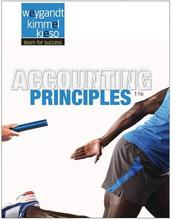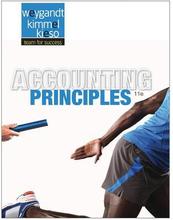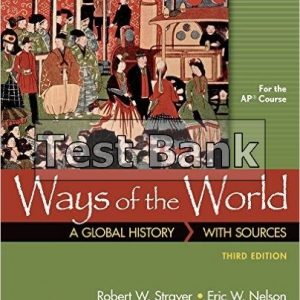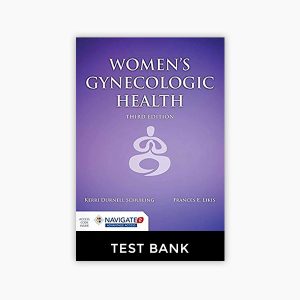Instant download Accounting Principles Weygandt 11th Edition Test Bank pdf docx epub after payment.

Product details:
- ISBN-10 : 111856667X
- ISBN-13 : 978-1118566671
- Author:
Accounting Principles 11th edition, by Weygandt, Kimmel, and Kieso provides a clear introduction to financial accounting that is full of real world examples that are relevant to students’ lives. The Team for Success authors understand where students struggle in this course and have developed a learning system that illustrates the accounting cycle and key transactions, while giving them the tools to apply their learning through sample exercises throughout the chapter. By expanding coverage of IFRS, this edition keeps students at the forefront of global issues that impact their future careers in business and accounting.
Table of contents:
Chapter 1 Accounting in Action 2
Feature Story: Knowing the Numbers 2
What Is Accounting? 4
Three Activities 4
Who Uses Accounting Data? 5
The Building Blocks of Accounting 7
Ethics in Financial Reporting 7
Generally Accepted Accounting Principles 8
Measurement Principles 9
Assumptions 10
The Basic Accounting Equation 12
Assets 13
Liabilities 13
Owner’s Equity 13
Using the Accounting Equation 15
Transaction Analysis 15
Summary of Transactions 20
Financial Statements 21
Income Statement 23
Owner’s Equity Statement 23
Balance Sheet 24
Statement of Cash Flows 24
APPENDIX 1A Accounting Career Opportunities 29
Public Accounting 29
Private Accounting 30
Governmental Accounting 30
Forensic Accounting 30
“Show Me the Money” 30
A Look at IFRS 48
Chapter 2 The Recording Process 52
Feature Story: Accidents Happen 52
The Account 54
Debits and Credits 54
Summary of Debit/Credit Rules 58
Steps in the Recording Process 58
The Journal 59
The Ledger 62
The Recording Process Illustrated 65
Summary Illustration of Journalizing and Posting 71
The Trial Balance 72
Limitations of a Trial Balance 73
Locating Errors 74
Use of Dollar Signs 74
A Look at IFRS 96
Chapter 3 Adjusting the Accounts 98
Feature Story: Keeping Track of Groupons 98
Timing Issues 100
Fiscal and Calendar Years 100
Accrual- vs. Cash-Basis Accounting 100
Recognizing Revenues and Expenses 100
The Basics of Adjusting Entries 102
Types of Adjusting Entries 103
Adjusting Entries for Deferrals 104
Adjusting Entries for Accruals 110
Summary of Basic Relationships 116
The Adjusted Trial Balance and Financial Statements 119
Preparing the Adjusted Trial Balance 119
Preparing Financial Statements 119
APPENDIX 3A Alternative Treatment of Prepaid
Expenses and Unearned Revenues 124
Prepaid Expenses 125
Unearned Revenues 126
Summary of Additional Adjustment Relationships 127
A Look at IFRS 157
Chapter 4 Completing the Accounting Cycle 160
Feature Story: Everyone Likes to Win 160
Using a Worksheet 162
Steps in Preparing a Worksheet 163
Preparing Financial Statements from a Worksheet 165
Preparing Adjusting Entries from a Worksheet 167
Closing the Books 167
Preparing Closing Entries 168
Posting Closing Entries 170
Preparing a Post-Closing Trial Balance 172
Summary of the Accounting Cycle 174
Reversing Entries—An Optional Step 175
Correcting Entries—An Avoidable Step 176
The Classified Balance Sheet 177
Current Assets 178
Long-Term Investments 179
Property, Plant, and Equipment 180
Intangible Assets 180
Current Liabilities 182
Long-Term Liabilities 183
Owner’s Equity 183
APPENDIX 4A Reversing Entries 188
Reversing Entries Example 188
A Look at IFRS 212
Chapter 5 Accounting for Merchandising Operations 216
Feature Story: Buy Now, Vote Later 216
Merchandising Operations 218
Operating Cycles 218
Flow of Costs 219
Recording Purchases of Merchandise 221
Freight Costs 222
Purchase Returns and Allowances 223
Purchase Discounts 224
Summary of Purchasing Transactions 225
Recording Sales of Merchandise 226
Sales Returns and Allowances 227
Sales Discounts 228
Completing the Accounting Cycle 230
Adjusting Entries 230
Closing Entries 230
Summary of Merchandising Entries 231
Forms of Financial Statements 232
Multiple-Step Income Statement 232
Single-Step Income Statement 236
Classified Balance Sheet 236
APPENDIX 5A Worksheet for a Merchandising Company—Perpetual Inventory 240
Using a Worksheet 240
APPENDIX 5B Periodic Inventory System 241
Determining Cost of Goods Sold Under a
Periodic System 242
Recording Merchandise Transactions 243
Recording Purchases of Merchandise 243
Recording Sales of Merchandise 244
Journalizing and Posting Closing Entries 245
Using a Worksheet 246
A Look at IFRS 271
Chapter 6 Inventories 274
Feature Story: “Where Is That Spare Bulldozer Blade?” 274
Classifying and Determining Inventory 276
Classifying Inventory 276
Determining Inventory Quantities 277
Inventory Costing 280
Specific Identification 281
Cost Flow Assumptions 281
Financial Statement and Tax Effects of Cost Flow Methods 286
Using Inventory Cost Flow Methods Consistently 288
Lower-of-Cost-or-Market 289
Inventory Errors 290
Income Statement Effects 290
Balance Sheet Effects 291
Statement Presentation and Analysis 292
Presentation 292
Analysis 293
APPENDIX 6A Inventory Cost Flow Methods in Perpetual Inventory Systems 297
First-In, First-Out (FIFO) 297
Last-In, First-Out (LIFO) 298
Average-Cost 298
APPENDIX 6B Estimating Inventories 300
Gross Profit Method 301
Retail Inventory Method 302
A Look at IFRS 324
Chapter 7 Accounting Information Systems 328
Feature Story: QuickBooks® Helps This Retailer Sell Guitars 328
Basic Concepts of Accounting Information Systems 330
Computerized Accounting Systems 330
Manual Accounting Systems 332
Subsidiary Ledgers 332
Subsidiary Ledger Example 333
Advantages of Subsidiary Ledgers 334
Special Journals 335
Sales Journal 336
Cash Receipts Journal 339
Purchases Journal 342
Cash Payments Journal 344
Effects of Special Journals on the General Journal 347
A Look at IFRS 371
Chapter 8 Fraud, Internal Control, and Cash 374
Feature Story: Minding the Money in Moose Jaw 374
Fraud and Internal Control 376
Fraud 376
The Sarbanes-Oxley Act 376
Internal Control 377
Principles of Internal Control Activities 378
Limitations of Internal Control 384
Cash Controls 386
Cash Receipts Controls 386
Cash Disbursements Controls 389
Petty Cash Fund 390
Control Features: Use of a Bank 394
Making Bank Deposits 394
Writing Checks 394
Bank Statements 395
Reconciling the Bank Account 397
Electronic Funds Transfer (EFT) System 401
Reporting Cash 402
Cash Equivalents 402
Restricted Cash 403
A Look at IFRS 425
Chapter 9 Accounting for Receivables 428
Feature Story: A Dose of Careful Management Keeps Receivables Healthy 428
Types of Receivables 430
Accounts Receivable 430
Recognizing Accounts Receivable 431
Valuing Accounts Receivable 432
Disposing of Accounts Receivable 438
Notes Receivable 441
Determining the Maturity Date 442
Computing Interest 443
Recognizing Notes Receivable 443
Valuing Notes Receivable 443
Disposing of Notes Receivable 444
Statement Presentation and Analysis 447
Presentation 447
Analysis 447
A Look at IFRS 468
Chapter 10 Plant Assets, Natural Resources, and Intangible Assets 470
Feature Story: How Much for a Ride to the Beach? 470
Plant Assets 472
Determining the Cost of Plant Assets 472
Depreciation 475
Expenditures During Useful Life 483
Plant Assets Disposals 484
Natural Resources 486
Depletion 487
Presentation 487
Intangible Assets 488
Accounting for Intangible Assets 489
Research and Development Costs 491
Statement Presentation and Analysis 492
Presentation 492
Analysis 493
APPENDIX 10A Exchange of Plant Assets 497
Loss Treatment 497
Gain Treatment 498
A Look at IFRS 517
Chapter 11 Current Liabilities and Payroll Accounting 522
Feature Story: Financing His Dreams 522
Current Liabilities 524
Notes Payable 524
Sales Taxes Payable 525
Unearned Revenues 526
Current Maturities of Long-Term Debt 526
Statement Presentation and Analysis 527
Contingent Liabilities 529
Recording a Contingent Liability 529
Disclosure of Contingent Liabilities 530
Payroll Accounting 532
Determining the Payroll 532
Recording the Payroll 535
Employer Payroll Taxes 539
Filing and Remitting Payroll Taxes 541
Internal Control for Payroll 542
APPENDIX 11A Additional Fringe Benefits 545
Paid Absences 545
Postretirement Benefits 546
A Look at IFRS 564
Chapter 12 Accounting for Partnerships 566
Feature Story: From Trials to the Top Ten 566
Partnership Form of Organization 568
Characteristics of Partnerships 568
Organizations with Partnership Characteristics 569
Advantages and Disadvantages of Partnerships 571
The Partnership Agreement 571
Basic Partnership Accounting 572
Forming a Partnership 572
Dividing Net Income or Net Loss 574
Partnership Financial Statements 576
Liquidation of a Partnership 578
No Capital Deficiency 579
Capital Deficiency 581
APPENDIX 12A Admission and Withdrawal of Partners 585
Admission of a Partner 585
Withdrawal of a Partner 589
Chapter 13 Corporations: Organization and Capital Stock Transactions 606
Feature Story: What’s Cooking? 606
The Corporate Form of Organization 608
Characteristics of a Corporation 608
Forming a Corporation 610
Stockholder Rights 612
Stock Issue Considerations 612
Corporate Capital 615
Accounting for Issues of Common Stock 617
Issuing Par Value Common Stock for Cash 618
Issuing No-Par Common Stock for Cash 618
Issuing Common Stock for Services or Noncash Assets 619
Accounting for Treasury Stock 620
Purchase of Treasury Stock 621
Disposal of Treasury Stock 622
Accounting for Preferred Stock 624
Dividend Preferences 625
Liquidation Preference 625
Statement Presentation 626
A Look at IFRS 644
Chapter 14 Corporations: Dividends, Retained Earnings, and Income Reporting 648
Feature Story: Owning a Piece of the Action 648
Dividends 650
Cash Dividends 650
Stock Dividends 654
Stock Splits 656
Retained Earnings 658
Retained Earnings Restrictions 658
Prior Period Adjustments 659
Retained Earnings Statement 660
Statement Presentation and Analysis 661
Presentation 661
Analysis 662
Income Statement Presentation 663
Income Statement Analysis 663
A Look at IFRS 682
Chapter 15 Long-Term Liabilities 684
Feature Story: And Then There Were Two 684
Bond Basics 686
Types of Bonds 687
Issuing Procedures 687
Determining the Market Price of a Bond 688
Accounting for Bond Issues 690
Issuing Bonds at Face Value 690
Discount or Premium on Bonds 691
Issuing Bonds at a Discount 692
Issuing Bonds at a Premium 693
Accounting for Bond Redemptions 694
Redeeming Bonds at Maturity 695
Redeeming Bonds before Maturity 695
Converting Bonds into Common Stock 695
Accounting for Other Long-Term Liabilities 696
Long-Term Notes Payable 696
Lease Liabilities 699
Statement Presentation and Analysis 700
Presentation 700
Analysis 701
APPENDIX 15A Present Value Concepts Related to Bond Pricing 705
Present Value of a Single Amount 706
Present Value of Interest Payments (Annuities) 707
Time Periods and Discounting 709
Computing the Present Value of a Bond 709
APPENDIX 15B Effective-Interest Method of Bond Amortization 711
Amortizing Bond Discount 711
Amortizing Bond Premium 713
APPENDIX 15C
Straight-Line Amortization 715
Amortizing Bond Discount 715
Amortizing Bond Premium 716
A Look at IFRS 735
Chapter 16 Investments 738
Feature Story: “Is There Anything Else We Can Buy?” 738
Why Corporations Invest 740
Accounting for Debt Investments 741
Recording Acquisition of Bonds 741
Recording Bond Interest 741
Recording Sale of Bonds 742
Accounting for Stock Investments 743
Holdings of Less than 20% 743
Holdings Between 20% and 50% 743
Holdings of More than 50% 743
Valuing and Reporting Investments 748
Categories of Securities 748
Balance Sheet Presentation 752
Presentation of Realized and Unrealized Gain or Loss 753
Classified Balance Sheet 754
A Look at IFRS 773
Chapter 17 Statement of Cash Flows 776
Feature Story: Got Cash? 776
The Statement of Cash Flows: Usefulness and Format 778
Usefulness of the Statement of Cash Flows 778
Classification of Cash Flows 778
Significant Noncash Activities 780
Format of the Statement of Cash Flows 780
Preparing the Statement of Cash Flows 782
Indirect and Direct Methods 782
Preparing the Statement of Cash Flows—Indirect Method 783
Step 1: Operating Activities 784
Summary of Conversion to Net Cash Provided by Operating Activities—Indirect Method 788
Step 2: Investing and Financing Activities 789
Step 3: Net Change in Cash 790
Using Cash Flows to Evaluate a Company 793
Free Cash Flow 793
APPENDIX 17A Statement of Cash Flows—Direct Method 798
Step 1: Operating Activities 799
Step 2: Investing and Financing Activities 803
Step 3: Net Change in Cash 805
APPENDIX 17B Using a Worksheet to Prepare the Statement of Cash Flows—Indirect Method 806
Preparing the Worksheet 807
A Look at IFRS 837
Chapter 18 Financial Statement Analysis 840
Feature Story: It Pays to Be Patient 840
Basics of Financial Statement Analysis 842
Need for Comparative Analysis 842
Tools of Analysis 842
Horizontal Analysis 843
Balance Sheet 844
Income Statement 844
Retained Earnings Statement 845
Vertical Analysis 846
Balance Sheet 846
Income Statement 847
Ratio Analysis 848
Liquidity Ratios 850
Profitability Ratios 853
Solvency Ratios 857
Summary of Ratios 858
Earning Power and Irregular Items 861
Discontinued Operations 861
Extraordinary Items 862
Changes in Accounting Principle 863
Comprehensive Income 864
Quality of Earnings 865
Alternative Accounting Methods 865
Pro Forma Income 865
Improper Recognition 866
A Look at IFRS 889
Chapter 19 Managerial Accounting 892
Feature Story: Just Add Water . . . and Paddle 892
Managerial Accounting Basics 894
Comparing Managerial and Financial Accounting 894
Management Functions 894
Organizational Structure 896
Business Ethics 897
Managerial Cost Concepts 899
Manufacturing Costs 899
Product versus Period Costs 901
Manufacturing Costs in Financial Statements 902
Income Statement 902
Cost of Goods Manufactured 903
Cost of Goods Manufactured Schedule 904
Balance Sheet 905
Cost Concepts—A Review 906
Product Costing for Service Industries 908
Managerial Accounting Today 909
Focus on the Value Chain 909
Balanced Scorecard 910
Corporate Social Responsibility 911
Chapter 20 Job Order Costing 938
Feature Story: She Succeeds Where Others Have Failed 938
Cost Accounting Systems 940
Job Order Cost System 940
Process Cost System 940
Job Order Cost Flow 941
Accumulating Manufacturing Costs 942
Assigning Manufacturing Costs to Work in Process 944
Manufacturing Overhead Costs 948
Assigning Costs to Finished Goods 952
Assigning Costs to Cost of Goods Sold 953
Summary of Job Order Cost Flows 954
Job Order Costing for Service Companies 955
Advantages and Disadvantages of Job Order Costing 957
Reporting Job Cost Data 958
Under- or Overapplied Manufacturing Overhead 958
People also search:
Accounting Principles
Accounting Principles Weygandt
Accounting Principles Weygandt 11th
Accounting Principles Weygandt 11th Test Bank
Accounting Principles Weygandt 11th Edition Test Bank





